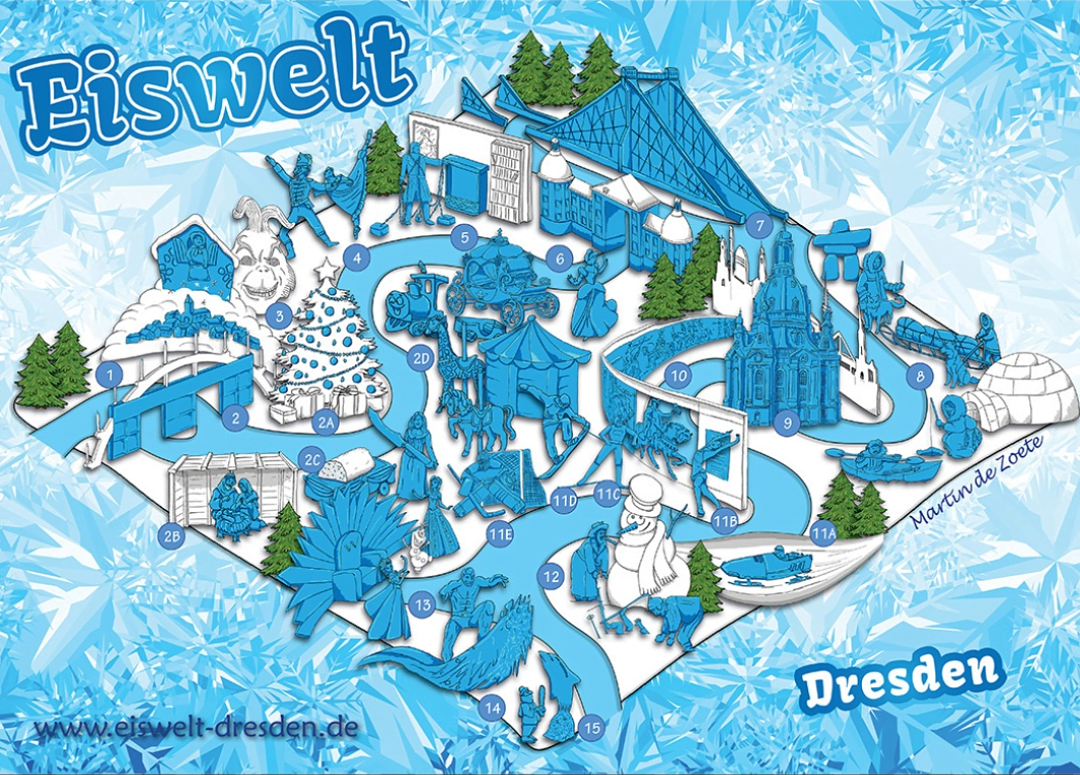Dresden’s Eiswelt (Ice World) Adds a New and Festive
Dimension to the Saxon City’s Christmas Appeal
In the eastern German state of Saxony, the Christmas markets are famous for their parades, Stollen, wooden nutcrackers, spinning pyramids and beautiful handcrafted goods. Dresden is one of the oldest markets in Germany known especially for its Stollen. Now this beautiful city has added a new winter attraction: the Dresden Eiswelt, or Ice World, where singular sculptures are worth a visit.
Saxony’s state capital of Dresden is admired for its beautiful architecture and extraordinary music and museums. Known as the Florence on the Elbe, every year tourists come to the city to visit the beautiful winding streets and alleyways, the re-creation of its grand buildings, including the Semper Opera, the Church of Our Lady, the royal castle and the Zwinger museums among many others. Ending a year of new things, the Dresden Eiswelt is a sparkling new winter attraction, and yet another reason to visit this beautiful city during the pre-Christmas season.
Located in a former factory near the Dresden Military History Museum, the Dresden Eiswelt is open to February 25, 2018. Sculptures adorn a large exhibition hall in a former factory and include 15 extraordinary figures from fairy tales and Christmas stories, such as the woman Holle, Charles Dickens’ Christmas Carol, the Grinch, the Blue Wonder (Dresden’s most famous bridge), the Church of Our Lady, a bobsleigh and the Prince and the Mouse King from The Nutcracker among many others. There is food and warm drinks for sale and a visit to the Dresden Military History Museum with the redesigned armory by Daniel Liebeskind is definitely worth an extra bit of time.
This year Dresden is celebrating its 583rd Striezelmarkt in the Altmarkt. Over 230 festive booths, the scent of mulled wine and roasting almonds create a beautiful Christmas scene from November 29 to December 24. A German Christmas specialty is the Stollen, and the Dresdner Christstollen, known to locals as ‘Striezel,’ is the most famous. In 1491, Pope Innocent VIII revoked the ban on butter and sent Dresden the ‘Butterbrief,’ or Butter Letter, that allowed the bakers to use richer ingredients, creating the Stollen we know today. The ‘Striezel’ or Dresden
Christstollen is so beloved in Dresden that they linked it to the Christmas market, where the Striezel was first sold around 1500. In 1730, Augustus the Strong, one of Saxony’s most famous electoral princes and biggest Stollen enthusiasts asked Dresden’s bakers to create a giant Stollen. It took 100 bakers and their assistants to create a Stollen that weighed 1.8 tons. This year, the Stollen is said to be four tons and a group of people will carry it to the Christmas market where it will be cut in pieces and served to everyone.
Christmas in Dresden is a true delight as there are many holiday activities, including further Christmas markets, and musical performances in addition to shopping and sightseeing. The Dresden Philharmonic will give three concerts on the 24, 25 and 26 of December in the new concert hall at the Kulturpalast; Bach’s Oratorio and many other concerts will be performed by various choirs at the Church of Our Lady (the Frauenkirche), the Church of the Holy Cross (Kreuzkirche), and the Dresden Zwinger. To round out a perfect day, visitors like to ice skate on the seasonal rink in the yard of the Hotel Taschenbergpalais Kempinski Dresden, the city’s premier hotel, located in the former crown prince’s palace. Christmas in Dresden is fit for kings after all!






